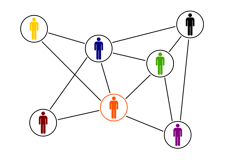Index Content
Inbound Marketing is no longer the great unknown. You publish anything with the word ATTRACTION in it and everyone's eyes widen.
- Hey, I have a company.
- Wow.
- And I attract leads naturally.
- really? How do you do that? Tell me the trick.
Well, it's just being in the right place at the right time with the right message. Because Inbound doesn't just care about who you are, it cares about what you do, what you enjoy and care about, what you take responsibility for and what keeps you awake at night. In other words, it all starts with a first approach, the rest of the way will come as you go along.
This is how attraction marketing works. We will talk about all this and much more in this Inbound Marketing guide. Will you join us?
Evolution of online marketing
do you remember what Inbound Marketing is? It is a methodology that consists of the use of non-intrusive marketing and advertising techniques, aimed at increasing the number of leads in order to convert them into customers. Its main difference with traditional marketing is that the focus is no longer on sales, but on the value provided to the target audience.
what is its origin?
- On the one hand, the concept of Inbound Marketing
We attribute it to the co-founders of HubSpot, Brian Halligan and Darmesh Shah, whose knowledge and experience led them to realise the power of generating valuable content to attract potential audiences.
When you have a blog and it starts to pick up volume, you have a CMS that allows you to manage content, you use Google Analytics, mailing tools and other techniques necessary to manage your community.
As a result, you end up having a lot of tabs in your browser to do your tasks, with data separated from each other. What these professionals did was to program an interface in which you had access to all these tools from a single place. And not only that, but they realised that all companies were going to need this. They called this ecosystem Inbound Marketing.
- On the other hand, the logic of the market
Before the 1990s, all the information that consumers received was controlled by companies. If you wanted to buy a product or service, it was the company that gave you the information, but the situation began to change radically with the arrival of the Internet. This was not just another shop window, but the beginning of an era that would change consumer habits forever.
With the internet came forums, blogs and social networks. Users had more and more spaces in which to express their opinions or share their shopping experiences, and to reach them they only had to use search engines.
Companies began to lose control of the information provided to users. Now, it was the users who had control of the information, to the point of democratisation. If companies wanted to attract potential customers, they had to become part of this community through the generation of valuable content.
it's selling without selling! Keep reading this Inbound Marketing guide to discover new related concepts.
Pillars that support Inbound Marketing
As companies have become more aware of this methodology and the change in user behaviour, they have paid more attention to this marketing philosophy. The ultimate goal is to attract the user in a natural way, and to do this, you must first know what are the pillars that support this methodology:
1- Content marketing. Why waste a paragraph saying nothing?
It is a strategy based on the creation, publication and dissemination of valuable content for your potential audience. The main requirements for implementing a content marketing strategy are: defining your potential audience or buyer persona, organising the knowledge you want to transmit (guides, videos, infographics, articles, copy on social networks, etc.) and studying the days of publication.
2- Email marketing: it allows those who haven't bought to buy, to buy, and those who have already bought, to repeat
This communication tool is one of the most effective techniques, as you can use it to set up e-mail campaigns to achieve communication objectives. It not only allows you to strengthen the link with the public by sending information of interest to them, but also to build customer loyalty and increase visits.
3- Social media. In the past, you were what you had. Now, you are what you share.
Blogs, social networks, forums and a long etcetera. They are all those media or communication platforms where you are present. It allows you to maximise the exposure of your campaigns, develop your own list of subscribers and measure results. How do users react to sharing your content?
4- Web positioning (SEO).
"Time puts everyone in their place, and if you do SEO, a little higher".
Yahoo, Google and a multitude of search engines were created in the 90s. The boom in websites and blogs became a fundamental showcase for companies on the Internet, so the objective was no longer just to sell, but to attract traffic. To do this, search engines became especially important, giving rise to SEO or Search Engine Optimisation. It is the positioning in search engines to improve the visibility of a website in organic results.
do you have doubts about the key concepts of the Inbound Marketing guide? Would you like to attract more potential customers but don't know where to start?
At Occam Digital Agency we can solve your doubts.




